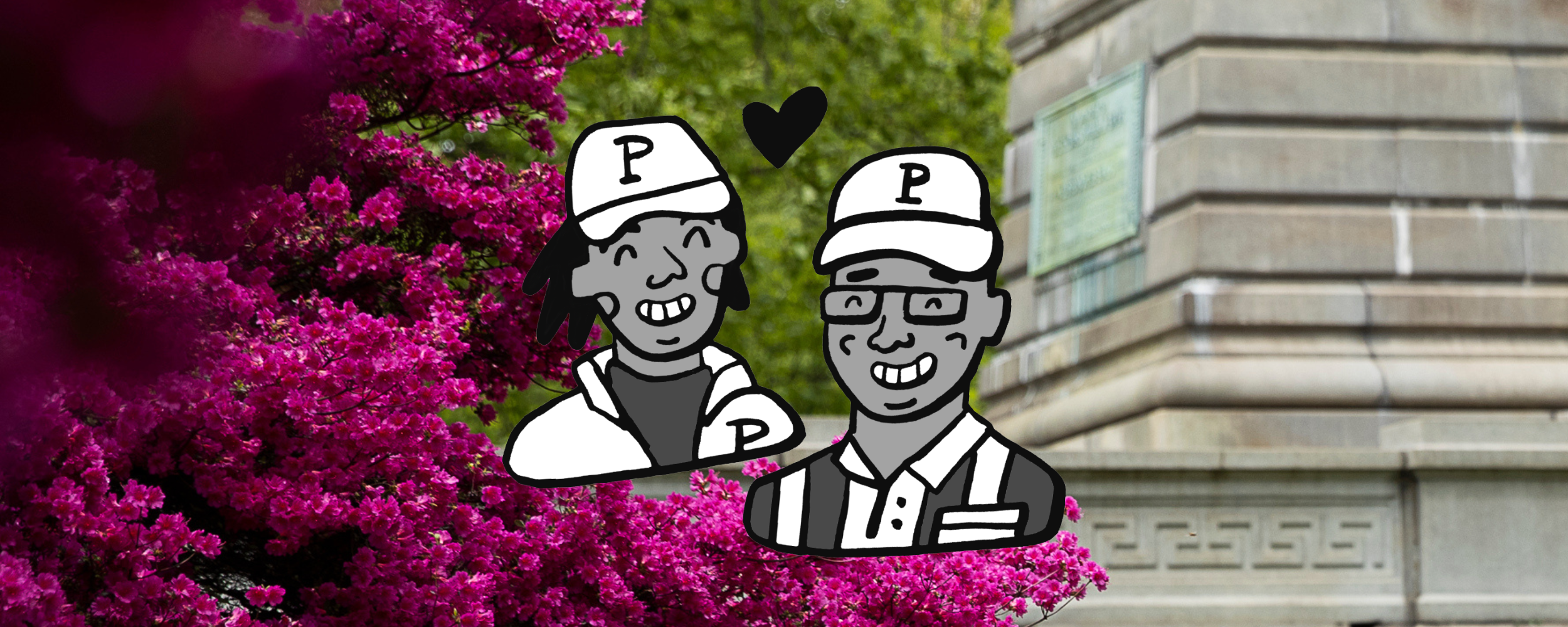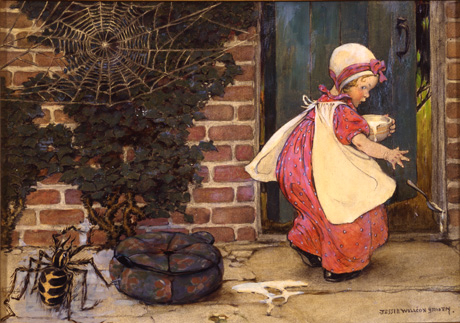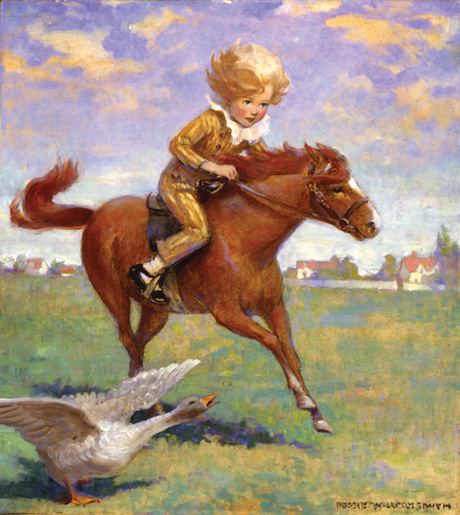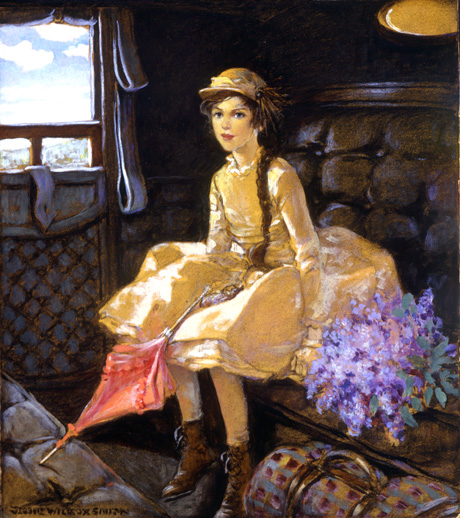We can’t get enough of Doris and Denis’ love story! Our neighbors told us the tale of their early courtship at The Woodlands: sitting at the base of Thomas Evans’ tomb, the tallest obelisk in the cemetery, Doris and Denis talked until 3:00 in the morning, the catalyst for their decades-long love.
Read More(Photo of Mary Grew and Margaret Burleigh from twitter thread by the Daily Suffragist here.)
Ongoing Research: Pride at The Woodlands
As Pride Month comes to an end, we are highlighting stories that celebrate LGBTQ+ love and partnership. While we have no shortage of influential figures to commemorate here at The Woodlands, we want to take this opportunity to re-introduce some of our favorite notables whose relationships defied social constructs of their time.
Read MoreWilliam Hamilton's Roses
William Hamilton was famous for his voracious plant collecting, and was passionate about rare plants. His greenhouse at The Woodlands held over 10,000 plant specimens and was one of the most important horticultural sites in the country in the 18th century. In celebration of Valentine’s Day Weekend, we are sharing the story of how the first red roses were introduced to America by our own William Hamilton at The Woodlands.
In November, 1785 William Hamilton wrote to his private secretary in Philadelphia of the “red monthly rose” and in February, 1788 he wrote again of “the two or three cuttings of the china rose, which I planted in pots.” The rose Hamilton was referring to was known commonly as ‘Slater’s Crimson China’ and was one of the first four “stud roses” to come from China.
Before the last decades of the 18th century, the only roses with which Westerners were familiar were fragrant, pink flowered, coarse shrubs that bloomed once a year in late spring. These flowers were popular but were mostly admired for their medicinal value. The arrival of the China roses created both excitement and lust among European and American gardeners. The flowers of the China rose themselves were small and scentless, borne on twiggy, somewhat shapeless plants. What was revolutionary about these roses was the color of the flowers, which opened true red, yellow, and blush, depending on the variety.
Roses planted by a Grave Gardener in the Jayne Family Plot at The Woodlands.
Pictured here is a red China rose planted in one of two grave gardens in the Jayne Family Plot in Section D, not far from the Hamilton Mansion. Dr. David Jayne was a 19th century doctor who operated a pharmacy in Philadelphia and exported medicines worldwide. The rose planted here represents both the history and value of early roses, and the new possibilities the China Red Rose offered the gardening world.
Hamilton was one of the first-if not the very first- persons in America to acquire the China rose. There would be no red roses in your Valentine bouquet if not for the introduction of China rose, and for the accomplishments over the next two centuries of many horticultural careers devoted to its hybridization. Crossed with the old European varieties, it is the ancestor of nearly all the modern roses we love today.
‘Country dances’ were performed by couples in two rows of parallel lines separating the men and women. The long, narrow ballroom in the City Tavern accommodated these choreographed dances. (Illustrations from William Hogarth’s The Analysis of Beauty, London, 1753)
Jane Austen, Would You Have This Dance?
Dancing Assemblies were held in the City Tavern, pictured to the left of the Bank of Philadelphia, from around 1773-1791. Its central location and weekly high-society events made it the social and economic heart of the city in the late 18th century.
Sketch of the City Tavern circa 1780’s. (Courtesy of the Historical Society of Pennsylvania)
In the domain of elite society in 18th Century Philadelphia, no other group had quite the influential flare as the Philadelphia Dancing Assembly. Established in 1749 by a group of gentlemen involved in the city’s political, professional, and mercantile businesses, the Dancing Assembly was modeled after London and Bath Assemblies of gentility and high-society entertainment. Participants and subscribers of the exclusive club utilized the weekly assemblies to show off their dancing talents, or participate in conversation and card games while eating and drinking the night away. Both a determinant of social status and an opportunity to mingle with Philadelphia’s single elite, a colonial gentleman or lady could display their extraordinary taste in leisure activities, privileged wardrobe, and dancing prowess at a gathering. Interestingly, religious affiliations were not a consideration in determining eligibility.
Among the notable member families were the Bond’s, Shippen’s, Plumstead’s, and our favorite socialite family, the Hamilton’s! Seasonal ticket purchases confirm our own William Hamilton and his family were among the fashionable, social gentility taking part in Dancing Assembly events of the late 18th century. [1]
Special Dancing Assembly events took place around Philadelphia in grand venues of political and social acclaim, including City Tavern at 2nd and Walnut Streets and OEller’s Hotel, on the south side of Chestnut Street, between 5th and 6th Streets. Live music filled the gatherings each year between the months of January and May, as 10 couples at a time participated in formal “minuets” and rowdy “country dances”.
October 1, 1772 Assembly Ticket. (Courtesy of the Historical Society of Pennsylvania)
Couples waiting for their turn to dance were encouraged to mingle, play cards, and enjoy a variety of wines, liquors, teas, coffees, chocolate, and simple cakes or biscuits. Single men were encouraged to officially court the single women they were paired with. Dancing Assembly gatherings even took place during the American Revolution (though much less frequently than other years) as Philadelphia was a hub of political, social, and military activity. They were a setting of communication between domestic and international leaders as well as leisurely escapism from the troubles of war time; a diversion or distraction afforded to the city’s elite.
A ‘minuet’ would generally begin every formal ball in the 18th century as an honorable tradition. A minuet began with formal bows and curtsies, followed by specific steps in a “S” pattern. (Illustrations from Kellom Thomlinson’s Art of Dancing, London, 1735)
Publications like this would be accessible only to the upper class in the U.S. to learn the proper etiquette.
Dancing Assembly gatherings became such an exciting cultural institution for the city that they attracted families of the highest regard. During his presidency, George Washington’s birthday was celebrated in special Dancing Assembly balls and it is recorded in member correspondences that Washington himself attended various member events when Philadelphia was the capital of the United States. So, the Hamilton’s were dancing among quite important company! Their membership in the Philadelphia Dancing Assembly exemplified their elite wealth and social prominence in the city, and the legacy of the Assembly cannot be understated. In Philadelphia, the Dancing Assembly continued throughout the 19th and well into the 20th centuries. The spirit of high-society mingling and entertainment also inspired similar membership-based gatherings in cities all across the developing United States. At each, the dress, manner, and dancing skill of each family further elevated their social status.
After 1791, Dancing Assemblies were held in the famous Oeller’s Hotel, pictured on the far right, recounted in traveler publications as having an elegant room in the French fashion, (Courtesy of the Library Company of Philadelphia)
To celebrate a tradition of the Hamilton family, (with a nod to Jane Austen too!), The Woodlands is hosting Jane Austen Night, Friday, February 28th, featuring the Germantown Country Dancers. For one night only enjoy seasonal treats, drinks, dance like the elite members of Philadelphia Dancing Assembly members did so many years ago. How will your dancing skills compare?
Learn more about Jane Austen Night and get tickets here.
Written by: Nicole Felicetti
1. Brooks, Lynn Matluck. "The Philadelphia Dancing Assembly in the Eighteenth Century." Dance Research Journal 21, no. 1 (1989): 1-6. Accessed February 4, 2020. doi:10.2307/1478608.
Jessie Wilcox Smith & The Red Rose Girls
As part of our Halloween celebrations this year we're focusing on some of the incredible women who are buried here at The Woodlands. Curio Theater Company is bringing to life the stories of five "Wicked Women of The Woodlands" by exploring what it meant to be an independent, courageous, and defiant woman in the Victorian era. Read on to learn about one of the most extraordinary women buried here, a Philadelphia Illustrator, Jessie Wilcox Smith.
Jessie Willcox Smith was born on September 6, 1863 in the Mount Airy neighborhood of Philadelphia to Henry Smith and Katherine DeWitt Willcox Smith. She taught as a kindergarten teacher until 1883, when she sat in on a cousin’s art lesson and became an artist at the age of 20. She is considered to be "one of the greatest pure illustrators" and has been a significant influence to generations of illustrators who came after.
Smith established herself as an artist in Philadelphia but soon gained national fame. In 1884, Smith attended the Philadelphia School of Design for Women, now Moore College of Art and Design. In 1885, she attended the Pennsylvania Academy of Fine Arts and studied under Thomas Eakins and Cecilia Beaux and graduated in 1888. In 1894, Smith enrolled in classes taught by Howard Pyle, often considered the father of American illustration, at Drexel University. Almost half of Pyle’s students were women. Pyle’s belief in the equality of men and women was central to his teaching, and Smith would later state that working with Pyle swept away "all the cobwebs and confusions that so beset the path of the art-student." Smith was strongly influenced by Pyle’s illustration technique, including the romantic idealism that became characteristic of her own artwork. After graduating from Drexel University, Smith studied at the Brandywine School under Pyle. Unlike most of her male peers who moved to New York to pursue careers in illustration, many of the women that graduated from Drexel University and the Brandywine School stayed in Philadelphia to pursue their careers. Some of these women remained close friends after graduation and became associated with a sense of community that fostered a gentle, naturalistic, and romantic art style among the individual artists. The women that graduated from the Brandywine School became known as “the Brandywine Girls,” and later, Jessie Willcox Smith would join two fellow artists as a lifelong peer, housemate, and friend.
Photo courtesy of the Pennsylvania Historical Society.
Jessie Willcox Smith, Violet Oakley, and Elizabeth Shippen Green shared an apartment on 1523 Chestnut Street in Philadelphia where they lived and worked. According to Patricia Likos, “the combination of these conventionally fine ladies and their unusual living arrangements made them local curiosities and provided them with a great deal of unrequested publicity.” In 1902, the women moved from Philadelphia to the Red Rose Inn, a country estate of several buildings that were separated by gardens and surrounded by trellises near Bryn Mawr, PA. Many newspapers and journals documented the artists’ move from 1523 Chestnut Street. Critics said that it was risky for the women to distance themselves from the city and from publishers, but others argued that the natural beauty of the country would be a “mental tonic” and serve as inspiration to the illustrators. Despite their new residence, the women’s popularity and renown continued to grow. Fans and tabloids became fascinated with the three successful and enigmatic artists, lovingly dubbing them “The Red Rose Girls.” In 1905, the Red Rose Inn property was sold and the women moved to a farmhouse that was remodeled for them by Frank Miles Day along Cresheim Creek in West Mount Airy. It was called “Cogslea,” ‘Cogs’ being an acronym for the surnames of Oakley, Green, Smith, and Henrietta Cozens, who had lived at the Red Rose Inn as a housekeeper and friend, and ‘lea’ describing the slope of the hill of the estate. Eventually, Green of the Red Rose Girls got married and moved from Cogslea, but the Red Rose Girls lived and worked together until 1911 and remained friends for the rest of their lives. Later in her life, Willcox bought a section of Cogslea and called it “Cogshill.” She lived there until her death in 1935.
All three of the Red Rose Girls achieved a great deal of commercial success, though Jessie Willcox Smith was perhaps the most commercially successful and was known as “the mint” among the housemates at Cogslea. Before studying under Howard Pyle, Smith found work at Ladies’ Home Journal. She later designed every cover of “Good Housekeeping” for 15 consecutive years, illustrated best-selling versions of Little Women, and illustrated covers for many magazines and books, including Harper’s, McClure’s, Scribner’s, A Child’s Garden of Verses by Robert Louis Stevenson, Mother Goose, The Water Babies by Charles Kingsley, and The Seven Ages of Childhood by Carolyn Wells. The Golden Age of American Illustration opened up new opportunities for women artists, and Smith’s success stemmed in part from a changing attitude towards women in the art world. Christine Huber writes that “women artists wanted to be equal to men; however, they did not want to become men, or give up traditional womanly virtues— selflessness, beauty and charm, motherhood, devotion to others and gentleness.” These womanly qualities were prized by publishers, and illustration was considered a very feminine craft because it required the “insight and patience that was part of a woman’s “temperamental equipment’” One writer described the Red Rose Girls as “lovely echoes of their clever and beautiful work."
To promote their artwork and expand their audience, the Red Rose Girls became involved with the Plastic Club, the oldest women’s art club in the country, founded in 1897. Smith, Oakley, and Green were all members of the Plastic Club, and all served on the Committee of Designs and Posters, which Jessie Willcox Smith chaired for three years.
Photo courtesy of the Pennsylvania Historical Society.
It was not unusual for women art students to share an apartment, which was often called “baching it” or “a Boston marriage,” but the Red Rose girls certainly developed an exceptional friendship centered around their artwork. They not only lived together, but spent almost every day together, and often collaborated on artwork— Smith and Green illustrated the Bryn Mawr College Calendar together, and all three of the Red Rose Girls designed the poster for a joint Plastic Club Exhibition in 1902. Their working relationship was called “an experiment,” “a partnership,” “a school,” “a colony,” “a community,” or “an art center,” by newspapers, and even now, many aspects of Jessie Willcox Smith’s are unknown, but it is clear that the Red Rose Girls drew a great deal of happiness and inspiration from one another, and in turn, forged their ways in the art world and influenced the future of American illustration.
Jessie Willcox Smith died on May 3, 1935 at Cogshill and was buried at The Woodlands Cemetery. Jessie Willcox Smith defined the Golden Age of American Illustration and paved the way for artists to come. Years later, her artwork continues to evoke a sense of peace and romanticism, and so her burial place at the Woodlands, surrounded by historic and natural beauty, seems especially fitting to remember her by. She can be visited at the Woodlands Cemetery in Section F, Lot #220.
Written by: Eva Karlen

















